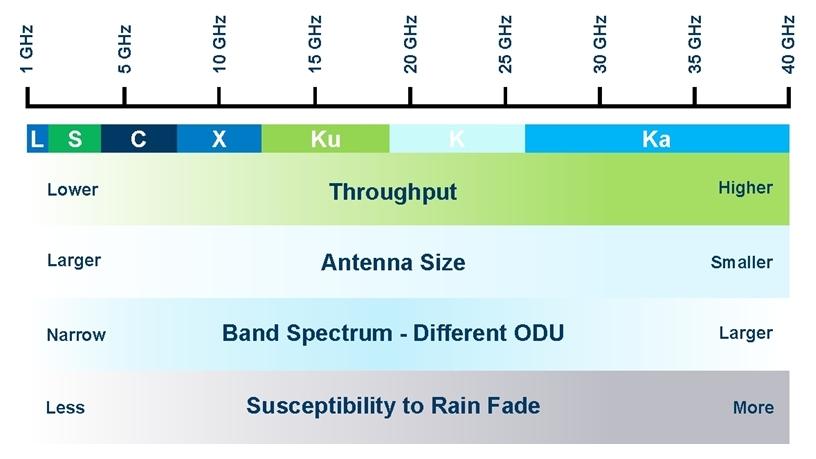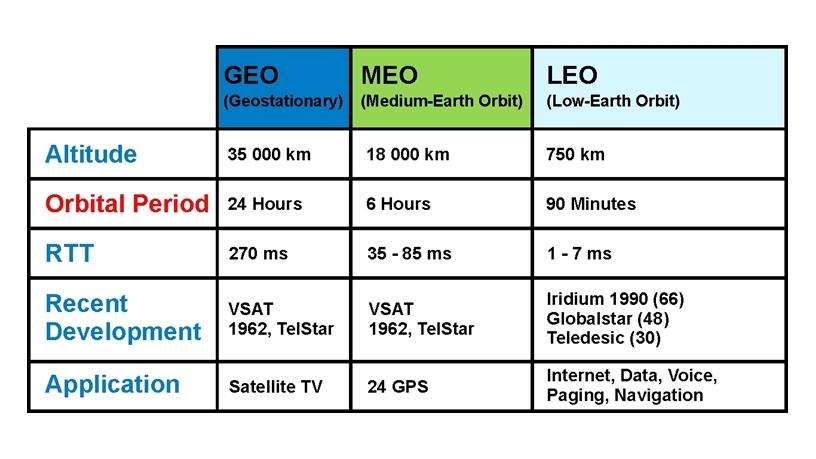
All industries have jargon, acronyms and code words that make the experts look smarter while mostly just confuse the rest of us. Unfortunately, the satellite industry is no different, and with the recent new technology developments, this has further increased the general level of confusion in the market.
While a detailed discussion might not help to clarify anything, the aim of this brief overview is to provide first order context to managers and executives who have to engage in satellite-related discussions.
In principle terms, satellite services are designed to operate on different frequency bands, either C-band, Ku-band or Ka-band, and at different geographical locations relative to the earth, either low earth orbits (LEO), medium earth orbits (MEO) or geostationary satellites. Since the telecommunications industry is now starting to use satellite services within all these parameters, the product and services discussion can become more confusing.
Influence of different frequency bands
First, we will consider the frequency bands. The satellite industry started in the 1960s using C-band, then introducing the Ku-band service around 2000 and Ka-service around 2010.
It is very important to note that all frequency bands are equally relevant for today's market and new solutions are being developed using all possible frequency bands.
Even the latest high throughput satellite services from Intelsat are being designed using C-band frequency channels, while other operators use Ka-band frequencies to design solutions for large area coverage.
The reality is that the frequency spectrum is a natural and very scarce resource, specifically for global satellite networks. In classic terms, C-band, Ku-band and Ka-band services used to have some distinct differences as outlined in the attached diagram. However, advanced designs and engineering methodologies have, to a great extent, smoothed these lines. Today, networks are being designed to make maximum use of available frequency bands and eliminate any user constraints that might be applicable.
These differences are no longer materially dictating the outcome of network performance and our recommendation to end-users is to rather focus on the advantages of the service and not the actual frequency band used.

If the service under consideration can meet the user requirement in terms of signal coverage, performance and cost, then it doesn't really matter what frequency band is used. The future HTS services will provide equally compelling value offers and feature sets in C-, Ku- or Ka-band. It is no longer valid to consider C-band as an "old" technology and Ka-band as the best option purely because it was more recently developed.
Satellite orbits and geographical metrics
Until recently, communication satellites were geostationary earth orbit (GEO) satellites, which were all located on the arc around the equator and with a position relatively fixed with regards to a point on earth. This worked very well, until demand for more telecommunications services exceeded supply. This specific orbital arch (known as the Clarke belt) has a finite quantity of positions available for satellites, and continued growth is a complex situation.
Partly for this reason, and also to improve cost and performance, leading innovators such as OneWeb and Space-X started to develop satellite network solutions using the LEO architectures.
These LEO networks have some key differences that can be advantageous for communication networks. Firstly, the communication round-trip time (RTT) is 15msec as opposed to 550msec for GEO satellites; and secondly, the ground terminal equipment can become very cost-effective and easy to deploy.
The LEO telecommunications networks planned for the near future are expected to service new and emerging markets, such as the connected car, 5G expansions and Internet of things market sectors. These sectors require completely different customer terminals, which are open standard and will operate on different satellite constellations.
For end-users, the fundamental to note is that LEO satellites are still very much emerging, with the first large-scale development expected towards end 2019. These are the satellite solutions that will have much quicker transmission latency delays (20msec) and which will connect mobile and portable terminals. These networks are on the horizon and set to further grow and change the satellite landscape.
Share